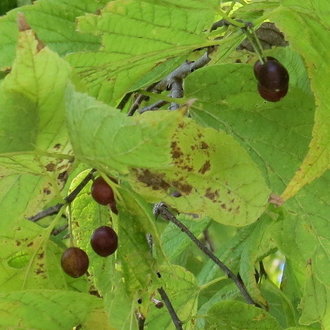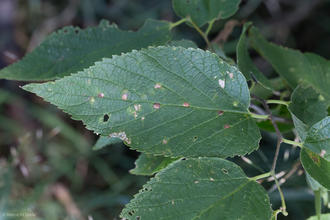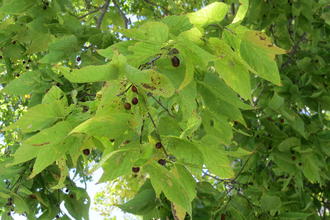Common Hackberry (Celtis occidentalis L.)
↑Summary
A tree with a distinctive warty bark, conspicuously asymmetrical leaves, and small berries that somewhat resemble dates in their hard, crunchy, and sweet flesh surrounding a single seed.
↑Range - Expand
| Legend | Color |
| Native | |
| Introduced | |
| Native or Not Present | |
| Introduced or Not Present | |
| Native or Expanded | |
| Expanded or Introduced or Not Present |
This map is based on our research. We have checked its accuracy to Level 3 ecoregions. Although this plant occurs somewhere in each of these regions, it may only occur in a small part of some or all of them.
This species has established new populations in Colorado, Utah, and northeastern Arizona; we mark those in eastern CO as Expanded because they are close to the native range and in the same ecoregions with no clear geographic boundaries. Populations farther west we mark Introduced because they are separated from the native range by larger distances, but they are close enough they could perhaps be marked Expanded as well.
↑Habitat
Common hackberry is found in hardwood forests on neutral-to-high pH soils throughout the northeastern to central US, with scattered populations extending into the south. It is most common in bottomlands along rivers and streams, but is also found occasionally on drier uplands, including open woods, rocky hillstones, limestone outcroppings, and sand barrens.
Its habitat preferences vary considerably by region. In the western part of its range, through the great plains, where rainfall is lower, and thus mineral leaching from soil is also lower, it is restricted to richer and more sheltered sites, mostly river valleys, ravines, and north-facing slopes, but it is more likely to occur on sandy soils. In the south and east, sites with sandy soils usually have too low a pH for it.
In the northwest of its range, from the Great Lakes region into the great plains, and throughout its range on limestone soils, it becomes more likely in dry habitats. In areas with more acidic soils, it becomes more restricted to bottomlands along streams and rivers in part because these areas have higher soil pH.
It is common on high pH soils, especially those derived from limestone, and intolerant of acidic soils, with a lower pH limit of about 5.0. Although growth is best on nutrient-rich soils, it can sometimes be found on nutrient-poor soils, where it grows slowly. It seems largely indifferent to soil texture, being found on thin, rocky soils, deep loams, clays, and sands.
Common hackberry tolerates soil saturation and substantial temporary flooding, but is absent from areas that are consistently saturated in all years as seedlings usually not able to survive to maturity in saturated soil.
It is found in all successional stages, including old-growth forests, but is usually uncommon in mature forests, especially on mesic sites. It is most common in forests at intermediate stages of succession, but even there is rarely found in pure stands.
For unknown reasons, this species is thought to benefit from the presence of common buckthorn (Rhamnus cathartica), an invasive species that displaces many native plants; it seems to regenerate well under buckthorn and may benefit from buckthorn shutting out competing tree species.
↑Life Cycle
Common hackberry is a relatively short-lived, large tree.
Seeds germinate aboveground. Seedlings establish better when the seeds are buried by some soil and/or leaf litter, and do not usually establish on exposed mineral soil or disturbed areas. Studies of seedling survival and establishment have found rather different results in different parts of this species' range. It often establishes under the shade of other species, including under a closed canopy, but can sometimes establish in open conditions. The best establishment seems to occur under somewhat open canopies, such as the conditions left by dead trees.
The root system develops differently based on the soil type and moisture conditions. On poorly-drained soils such as clay, and on sites with high water tables, roots develop laterally and remain shallow, and plants usually lack a strong taproot. On deep, better-drained soils, deeper root systems develop. The roots form ectomycorrhizae, a less-common type of mycorrhizal relationship with fungi, in which the fungi remain outside the root's cell walls.
Growth rate is highly variable based on site conditions and competition from other plants, with the fastest growth on moist, sunny sites. Growth is suppressed on dry or nutrient-poor sites, or in shade, but most estalished seedlings still survive even in these conditions. The bulk of growth usually occurs between 20 and 40 years of age.
Seed production is consistent in most years, but some years have lighter crops. The seed ripens in early fall, but often remains on the tree through winter, until it is eaten by birds or other animals. Seeds are distributed by fruit-eating birds and other animals, and also by gravity. Seeds begin to germinate after a period of cold dormancy, but only about a third germinate in their first year, with slightly fewer germinating in the second year. It is not known how many years the seed stays viable, but it does appear to form at least a short-term seed bank. An experiment found that some seed stays viable over 5 years, but it is not known whether this would occur in natural conditions.
Saplings have a high potential to resprout if top-killed, and can resprout in response to fire, browsing, cutting, or other disturbances. Under certain circumstances, notably when a wide-spreading root system experiences high-light conditions far from a tree's original trunk, this species can grow multiple trunks and form a vegetative clone or colony. This phenomenon is more common in anthropogenic habitats where landscaping removes other vegetation and creates soil disturbance, leading to high light conditions around the periphery of the root system. Common hackberry forms such colonies much less readily than other colony-forming tree species such as quaking aspen (Populus tremuloides), and when they do occur, such colonies tend to be smaller, with fewer trunks.
Most trees reach a maximum size of around 30-50 feet in height, but on the best sites, can reach to 130 feet, or 95 feet in the more arid west. Trees usually live to about 150-200 years of age.
Trees growing in bottomlands are often killed by large flooding events, with death usually occuring in the second or third season after a flood. Trees can also succumb to rot following mechanical damage. Although trees are generally windfirm and not often damaged in windstorms, they are highly susceptible to damage from ice storms. Trees of any age can be killed by fire, but mature trees are more likely to die completely and not resprout. Except in the driest parts of their range, trees are rarely killed by drought. On very rich sites, trees can also be killed by being overtopped and shaded by more shade-tolerant species.
↑Faunal Associations
Hackberry is an outstanding species for supporting the food web across the board as it grows rapidly and many parts of the plant are highly palatable to both insects and larger animals.
The foliage is browsed by deer as well as livestock such as cattle. Hackberry is particularly important as a food source for white-tailed deer, which browse both foliage and twigs. It is primarily consumed in the summer, when it is often favored over average vegetation, although it is not among the most-preferred species. Heavy deer overpopulation can suppress hackberry establishment on a site. Young plants are browsed by rabbits, rodents, and groundhogs, and are among the types of browse most favored by groundhogs. Cattle usually only turn to hackberry on low-quality rangeland, when grass browse is sparse, but they may browse twigs in winter.
Eastern fox squirrels use hackberry trees as a nesting site, and eat the nipple galls formed in the leaves by the hackberry nipplegall maker (Pachypsylla celtidismamma).
The berries are consumed by birds, squirrels, raccoons, and box turtles, and is one of the fruits most preferred by raccoons. Birds consuming the fruit include the cedar waxwing, northern mockingbird, American robin, Eastern bluebird, yellow-bellied sapsucker, northern flicker, eastern bobwhite, wild turkey, and numerous others. Hackberry is a particularly important winter food source to eastern bluebirds. Woodpeckers and nuthatches also feed extensively in hackberry trees.
The trees are important as nesting sites for cavity-nesting birds. In part due to their rapid growth and short lifespan, they can be particularly valuable for providing cavity nesting sites in earlier stages of forest growth.
A large number of Lepidoptera species have been recorded eating common hackberry in the larval form, including both numerous specialists and generalists. The butterflies hackberry emperor (Asterocampa celtis) , the tawny emperor (Asterocampa clyton), and the American snout (Libytheana carinenta) and the moths Phyllonorycter celtifoliella) and Phyllonorycter celtisella eat this and other Celtis sp. The ruddy dagger moth (Acronicta rubricoma) eats this and other Celtis sp. along with elms (Ulmus) and sumacs (Rhus). The wild cherry sphinx moth (Sphinx drupiferarum) eats this tree along with several trees of the rose (Rosaceae) family. The hackberry leafroller moth (Sciota celtidella) also eats this species. The question mark (Polygonia interrogationis) eats trees of this genus along with other species in the nettle (Urticales) order.
The generalist mourning cloak (Nymphalis antiopa) butterfly, and the wood leopard moth (Zeuzera pyrina), fall cankerworm (Alsophila pometaria), spring cankerworm (Paleacrita vernata), American lappet moth (Phyllodesma americana), fall webworm (Hyphantria cunea), white-marked tussock moth (Orgyia leucostigma), the venomous southern flannel moth (Megalopyge opercularis), the evergreen bagworm (Thyridopteryx ephemeraeformis)), and the cecropia moth (Hyalophora cecropia) eat this and many other tree species. The hickory tussock moth (Lophocampa caryae) prefers hickories (Carya sp.) but also eats this species, and similarly the pink-striped oakworm moth (Anisota virginiensis) prefers other species but also eats this one, and the oblique banded leaf roller (Choristoneura rosaceana) prefers plants of the rose family but also eats this species. The introduced generalist spongy moth (Lymantria dispar) eats this among many species.
The high density of insect larvae in trees make them a favorite foraging spot for migrating warblers and other insectivorous birds.
↑Control
This species has high invasive potential and can be difficult to remove once established; it is important to avoid planting it far outside its native range. It has become invasive in central Europe, particularly Hungary, and has also been introduced in eastern Australia, although there it is not as invasive as the European hackberry (Celtis australis). In North America it has been introduced to areas west of its native range in AZ, UT, and CO.
Because in most regions where this species could become invasive, it is in the early stages of establishment, the most important aspects of control are to remove mature fruiting plants to limit its reproduction by seed. Because different Celtis species are often hard to identify, a limiting factor in control is identification skill, so educating people in how to identify this species so that they can remove it in these areas is critically important.
↑Uses
Common hackberry is infrequently planted as a landscaping plant, but well-suited to this purpose, when planted on soils with suitable pH. Its use may be limited by its strong preference for higher pH soils, combined with lower cultural awareness of soil pH and mineral content and the fact that these aspects of soil are less immediately visible than texture or moisture levels. Another factor limiting its use in landscaping is its short lifespan and poor rot resistance, leading trees to decline and die relatively quickly if they are mechanically damaged. However it is no less vulnerable than other species, such as silver maple (Acer saccharinum), that are widely planted and have more problems and drawbacks.
In landscaping, common hackberry is valued for the distinctive bark pattern on mature trees providing year-round visual interest, and for its elm-like growth habit. Its somewhat open canopy and nutrient-rich litter allows some gardening underneath, and its fruit, which are small and relatively dry, are less messy than those of other trees that bear small fruit.
Common hackberry has been used to rehabilitate land degraded by mining, where it can tolerate high lead and zinc content in soil, and sometimes colonizes formerly mined land on its own. It is more suitable for this use in the west of its range where mineral leaching is less due to lower rainfall. In higher-rainfall areas, mine spoils are often too acidic for it to survive.
Native American have used the fruits as a food source, using it both as a seasoning, and grinding up the fried flesh of the fruit and combining it with fat and corn. The fruit is high in vitamin A, calcium, and magnesium. The fruit are edible as-is, but very small. They have a firm, crunchy texture reminiscent of fresh dates, and a sweet, rich flavor similar to sweetened cooked carrot or sweet potato, but are also slightly astringent.
Hackberry is sometimes harvested for wood, where it is usually mixed together with sugarberry (Celtis laevigata). The wood superficially resembles ash, and is sometimes used as a substitute for it, but is structurally more similar to elm. It is considered to be one of the best woods for steam bending, but has poor durability and is susceptible to both rot and insect damage. It usually machines well, but sections can often have knots or interlocked grain that poses problems for machining.
↑Related Plants
Numerous other Celtis species occur in North America; most of them are native. Two species are probably the most closely related: the more southerly sugarberry (Celtis laevigata) overlaps over a large area from Virginia west through Oklahoma, netleaf hackberry (Celtis reticulata) overlaps from Oklahoma and western Nebraska through northeastern New Mexico. This species readily hybridizes with C. laevigata to where it is hard to identify all individuals.
A few non-native species have been introduced at isolated sites. Because Celtis species are hard to identify, it is possible that other species are underreported in the wild. However, species from other continents often have very different climate tolerances and are less competitive here than native species in this genus.
There are several other plants in other genera of the Cannabaceae or hemp family, and even more in the broader grouping that includes the Ulmaceae or elm family.
↑Links & External Resources
• Hackberry | The Wood Database (About This Site)
• Common Hackberry | Fire Effects Information System (FEIS) (About This Site)
• Celtis occidentalis (Common Hackberry) | Illinois Wildflowers (About This Site)
• Celtis occidentalis (Common Hackberry) | USDA PLANTS Database (About This Site)
• Celtis occidentalis | Go Botany (About This Site)
• Celtis occidentalis (Hackberry) | Missouri Botanical Garden Plant Finder (About This Site)
• Hackberry | Virginia Tech Dendrology Factsheets (About This Site)
• Hackberry | Silvics of North America (About This Site)
• Celtis occidentalis | Biota of North America Project (BONAP) (About This Site)
• Celtis occidentalis | NatureServe Explorer (About This Site)
• Celtis occidentalis | Flora of North America (About This Site)
• Celtis occidentalis | Missouri Plants (About This Site)
• Common Hackberry | Maryland Biodiversity Project (About This Site)
• Celtis occidentalis L. | Plants of the World Online (POWO) (About This Site)
• Celtis occidentalis L. (Common Hackberry, Northern Hackberry) | Digital Atlas of the Virginia Flora (About This Site)






